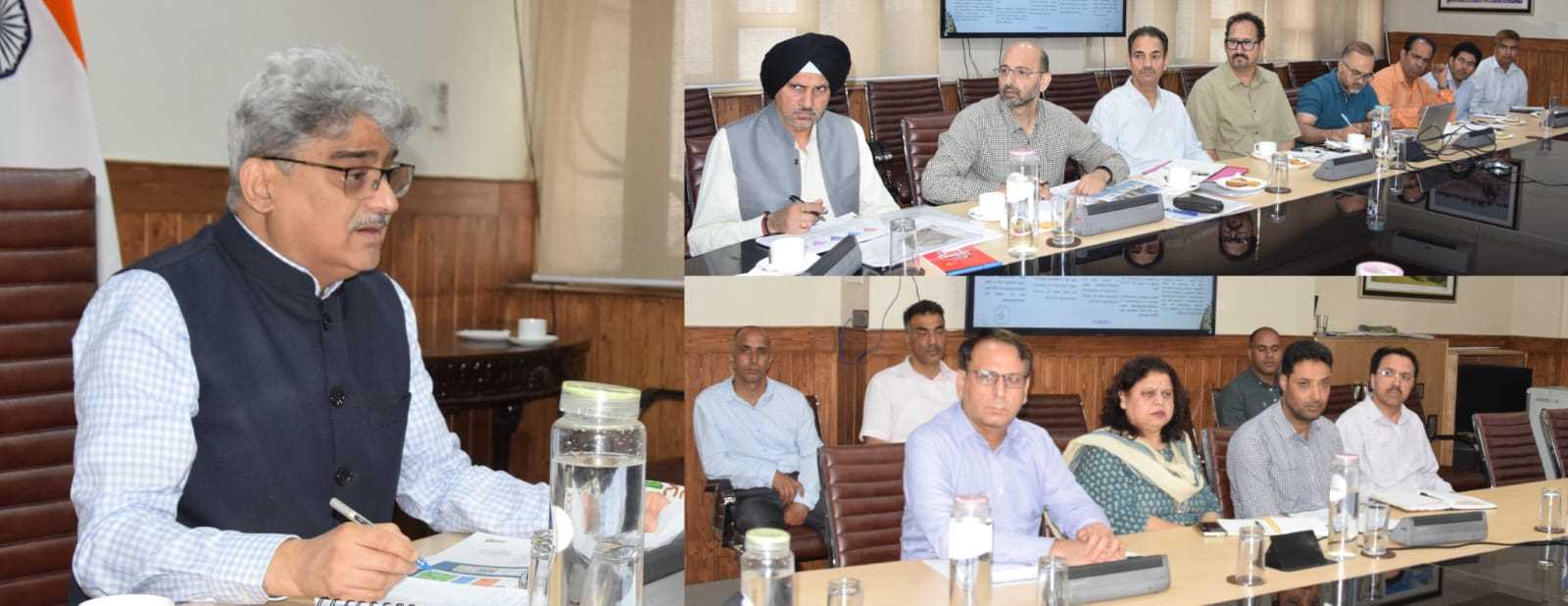
Chief Secretary Atal Dulloo chaired a high-level meeting to review the ongoing and proposed initiatives of the Handicrafts & Handloom Department aimed at preserving Jammu & Kashmir's rich craft heritage and improving the socio-economic conditions of artisans and weavers.
The meeting saw participation from Commissioner Secretary, Industries & Commerce, Vikramjit Singh; MD, JKTPO; and Directors of Handicrafts & Handloom, Kashmir and Jammu.
Emphasising the global demand for authentic handmade products, the Chief Secretary called for modern interventions like Geographical Indications (GI), QR code tagging, and digital authentication to safeguard genuine artisans from counterfeits. He stressed follow-up with the Government of India to expedite pending project proposals and recommended appointing a senior nodal officer for coordination.
Dulloo also directed fast-tracking the MoU with the World Craft Council to set up a World Craft Hub and Living Crafts Museum—envisioned as global centres for craft innovation and preservation.
Highlighting the potential of digital and social media for global outreach, he urged timely completion of Ekta Malls in Jammu and Srinagar to offer direct market access to artisans.
Commissioner Secretary Vikramjit Singh highlighted reforms post-2020 that strengthened artisan support, market access, GI protection, and financial empowerment. Notable schemes include the Credit Card Scheme for Artisans, Karkhandar Scheme, and Raw Material Banks.
Director Handicrafts & Handloom, Kashmir, Masrat-ul-Islam, presented key infrastructure projects including Craft Villages, Common Facility Centres, Flatted Factories, and De-hairing Plants. Proposed projects include the Craft Village at Sonpah (Budgam), Wool CFC at Nowshera (Srinagar), and Bamboo Cluster at Samba.
J&K remains the only UT to offer GI tagging for its entire craft basket, with GI-certified products featuring QR code labels detailing artisan identity, materials, and origin. A high-resolution microscope has helped reduce the GI backlog from 1709 to 150 in just four months.
So far, 15 crafts from Kashmir and 3 from Jammu have GI status, with more under consideration. Notable crafts include Sozni, Pashmina, Kani Shawls, Walnut Wood Carving, Basohli Pashmina, and Basohli Painting.
Capacity building efforts include 634 operational training centres. Handicraft exports peaked at Rs 1,116.37 crore in 2022–23 and stood at Rs 733.59 crore in 2024–25. Last year, the department earned Rs 9.64 crore from 15 exhibitions and continues to collaborate with JKTPO to support artisans through free or subsidised stalls.
Chief Secretary Atal Dulloo chaired a high-level meeting to review the ongoing and proposed initiatives of the Handicrafts & Handloom Department aimed at preserving Jammu & Kashmir's rich craft heritage and improving the socio-economic conditions of artisans and weavers.
The meeting saw participation from Commissioner Secretary, Industries & Commerce, Vikramjit Singh; MD, JKTPO; and Directors of Handicrafts & Handloom, Kashmir and Jammu.
Emphasising the global demand for authentic handmade products, the Chief Secretary called for modern interventions like Geographical Indications (GI), QR code tagging, and digital authentication to safeguard genuine artisans from counterfeits. He stressed follow-up with the Government of India to expedite pending project proposals and recommended appointing a senior nodal officer for coordination.
Dulloo also directed fast-tracking the MoU with the World Craft Council to set up a World Craft Hub and Living Crafts Museum—envisioned as global centres for craft innovation and preservation.
Highlighting the potential of digital and social media for global outreach, he urged timely completion of Ekta Malls in Jammu and Srinagar to offer direct market access to artisans.
Commissioner Secretary Vikramjit Singh highlighted reforms post-2020 that strengthened artisan support, market access, GI protection, and financial empowerment. Notable schemes include the Credit Card Scheme for Artisans, Karkhandar Scheme, and Raw Material Banks.
Director Handicrafts & Handloom, Kashmir, Masrat-ul-Islam, presented key infrastructure projects including Craft Villages, Common Facility Centres, Flatted Factories, and De-hairing Plants. Proposed projects include the Craft Village at Sonpah (Budgam), Wool CFC at Nowshera (Srinagar), and Bamboo Cluster at Samba.
J&K remains the only UT to offer GI tagging for its entire craft basket, with GI-certified products featuring QR code labels detailing artisan identity, materials, and origin. A high-resolution microscope has helped reduce the GI backlog from 1709 to 150 in just four months.
So far, 15 crafts from Kashmir and 3 from Jammu have GI status, with more under consideration. Notable crafts include Sozni, Pashmina, Kani Shawls, Walnut Wood Carving, Basohli Pashmina, and Basohli Painting.
Capacity building efforts include 634 operational training centres. Handicraft exports peaked at Rs 1,116.37 crore in 2022–23 and stood at Rs 733.59 crore in 2024–25. Last year, the department earned Rs 9.64 crore from 15 exhibitions and continues to collaborate with JKTPO to support artisans through free or subsidised stalls.
© Copyright 2023 brighterkashmir.com All Rights Reserved. Quantum Technologies